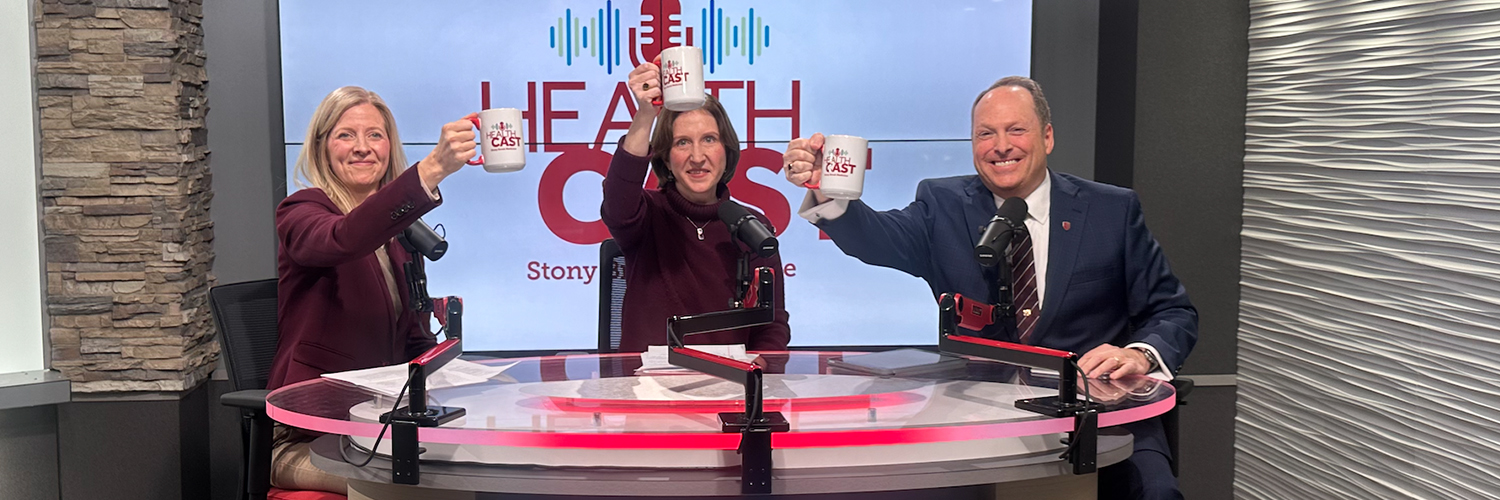In this episode of Healthcast, experts from Stony Brook Medicine discuss an important new pilot study that investigates the feasibility and benefits of telehealth in a cognitive behavioral therapy (CBT) group setting as a promising solution to address access to care and treatment challenges experienced by many people who live with functional movement disorder.
The Experts
What You’ll Hear in This Episode
- 00:00 Opening and Introductions
- 2:06 Functional Movement Disorders
- 3:55 Cognitive Behavioral Therapy (CBT)
- 5:06 Why Telehealth?
- 5:40 Group CBT
- 6:23 Factors in Designing the Pilot Study
- 10:35 Participation
- 11:45 Logistics of the Study
- 12:35 Measuring Success
- 14:54 Family Member Involvement
- 15:20 Next Steps
- 16:20 Closing Remarks
Full Transcript
00:00 Opening and Introductions
Announcer
Welcome to Healthcast, where leaders and experts from Stony Brook Medicine come together to discuss a range of topics from leadership and strategic planning to patient care and the inner workings of a successful healthcare system.
Timothy Brown
Welcome, everybody. We’re here today with Corinne and Dodie, who are co-principal investigators on an important new pilot study. It’s the only one of its kind. The study investigated the feasibility and benefits of telehealth in a cognitive behavioral therapy group setting as a promising solution to address access to care and treatment challenges experienced by many people who live with functional movement disorders. Those are disorders where timely treatment is crucial for achieving better outcomes.
Carine and Dodie, welcome to the program. We’re so happy you two could be on today. So, if we can start off with having each one of you introduce yourselves to our audience and tell us a little bit about what you do here at Stony Brook.
Carine Maurer, MD, PhD
Thank you. And thank you for the introduction and thank you for bringing us here today. So I am a movement disorders neurologist here at Stony Brook Medicine. More so I work in our Center for Parkinson’s Disease and Movement Disorders, where I see individuals with Parkinson’s disease, essential tremor, tics disorders and Tourette’s, as well as individuals with functional movement disorders.
Dodie Gillett, PhD
Hi. Thanks again for having us. I’m Dodie Gillette. I am here as part of the Department of Psychiatry and Behavioral Health. I’m a clinical psychologist and I work a lot with Carine, primarily actually with patients from neurology, also treating folks with tics and Tourette, functional movement disorders, as well as Huntington’s disease.
2:06 Functional Movement Disorders
Timothy Brown
Great. Okay, let’s start off with just kind of the basics so we can educate people and get them learning a little bit about functional movement disorders.
Can you explain that and provide examples?
Carine Maurer, MD, PhD
Sure. So this is a very common disorder that we see in the neurology clinic. However, despite being very common, it is oftentimes not recognized and is not really well understood. It can present with a wide variety of different movements, so it can present with tremor, it can present with jerky movements, it can present with gait abnormalities.
It is viewed as a neuropsychiatric disorder, where oftentimes stressors, whether they be physical stressors or psychological stressors, can play a role. Oftentimes, when we are trying to explain the condition to our patients, we explain it using the analogy of the brain as a computer. So we explain that there is not a hardware problem, so individuals with functional movement disorders can have all normal testing, they can have normal MRI, normal EEG, normal blood work. But we know that there’s a disconnect between certain parts of the brain that can contribute to their symptoms. And oftentimes these symptoms can be quite disabling.
Timothy Brown
Is there an age range that you traditionally see people?
Carine Maurer, MD, PhD
So the most common age of presentation is between the thirties and the fifties. But really, individuals can present at any age. So there can be pediatric patients, there can be geriatric patients.
3:55 Cognitive Behavioral Therapy (CBT)
Timothy Brown
So Dodie, we’re going to talk about cognitive behavioral therapy or CBT. Can you explain that to us?
Dodie Gillett, PhD
Sure. So cognitive behavioral therapy is known as CBT. The basics of cognitive behavioral therapy is we want to address an individual’s thoughts and behaviors that may be maladaptive, and then we look to shift those thoughts and behaviors to more adaptive thoughts or behaviors, which in turn really improves mental and emotional well-being.
So basically, if that’s at our core, we do a lot of work to help challenge negative thinking styles and patterns and again, improve those thought cycles. It’s an evidence-based practice. It tends to be time limited and we have a lot of evidence that it is very effective for a wide range of disorders.
There is a what’s considered a third wave of CBT that also is often incorporated into CBT work, and that’s sort of a more evolved way of looking at CBT. And instead of changing the thoughts, we look to accept those thoughts and help patients be non-judgmental about their experience. That’s more of our DBT (dialectical behavior therapy) and our mindfulness-based cognitive therapies as well.
5:06 Why Telehealth?
Timothy Brown
So why telehealth?
Dodie Gillett, PhD
Yeah. Well, first of all, I think it’s a wonderful option for a lot of patients, especially in my area in psychology, and that is very accessible to people.
And so specifically looking at telehealth for a group setting, it allows people to really attend those groups easily. They don’t have to worry about transportation if these are people, especially in this group, with physical limitations, they can easily get to a computer. It’s much more difficult sometimes to get to a clinic.
5:40 Group CBT
Timothy Brown
And I think there was some significance to group CBT versus individual. Why is that?
Dodie Gillett, PhD
Yeah, so group CBT has been done repeatedly in a wide variety of diagnoses. And it’s again definitely, absolutely an effective form of treatment. In terms of group therapy for what we were looking at is really access to care. So we have a lot of demand for services and less availability of providers to be able to provide those services.
So when we offer a group option, we can have a number of patients with one provider and it really does open up access to care.
6:23 Factors in Designing the Pilot Study
Timothy Brown
Great. So what are the factors looked at when determining how to design the study, how to do the study? Do either of you want to take that?
Carine Maurer, MD, PhD
So maybe we’ll share it because there are a lot of factors that we needed to consider in terms of the design of the study, one of which was how we were going to measure the success potentially, so what outcome measures we were going to use.
And so first we wanted to evaluate for feasibility; how easy it was for patients and how many patients actually completed the program. So really tracking the attendance of the patients. And then we also wanted, you know, looking at specifically what were important outcome measures. So what did we want to look at before the intervention and after the intervention.
And in there we took the lead from a publication from a couple of years ago that outlined the functional movement disorders core outcome measures. So not looking specifically at the abnormal movements that these patients have, but in terms of looking more at their quality of life, looking at their functional impairment and looking at their overall mental health, so many of these individuals also experience anxiety and depression. So we also wanted to make sure that we tracked that.
Dodie Gillett, PhD
Yeah, and in evaluating patients to be appropriate for the group. We just wanted to make sure that they had access to a computer or phone to be able to do the telehealth, engage in the telehealth, and that they had the sort of cognitive abilities to also to be able to engage in group and in telehealth.
Timothy Brown
So I am curious, you know, when we talk about the group dynamic, did you find that was actually helpful with some of these folks to know that there were other folks out there also suffering?
Dodie Gillett, PhD
Absolutely. I think that was probably our greatest takeaway from the group is that people absolutely reported a strong sense of community and feelings of support, as well as feeling almost like it was the first time they met somebody else who also had a functional movement disorder, which was validating for them to understand that they weren’t alone in the process.
Timothy Brown
Yeah, because I can imagine the isolation that probably a lot of the patients feel is debilitating in and of itself. But if you get some folks together and they can also see some benefit and progress, that has to be huge.
Carine Maurer, MD, PhD
Right. So this is a disorder that when I give the diagnosis to patients in the clinic, many of them have never heard of this disorder. It’s as I said, while it’s quite common, it’s not highly recognized among laypeople, and most people do not know somebody else with the condition.
So, yes, I think that that was one of the features of the program that patients really appreciated. And one aspect of our study is that patients were interviewed after participation and then a very talented medical student working with us did a thematic analysis where she found that patient’s highlighted that this connection with other patients was a feature that they really appreciated.
Timothy Brown
So that was almost an added benefit of the study? That’s great.
10:35 Participation
How many people participated?
Dodie Gillett, PhD
So we had 21 initially who enrolled and then we had 20 who completed. So we had a really nice completion rate. Once people started, they typically completed the group. We had three separate groups over approximately a year and a half period that ran 9 to 10 sessions per group. And so it was approximately 6 to 9 people per group.
Timothy Brown
And the majority of the participants were women, correct?
Carine Maurer, MD, PhD
That is correct. So I think that it was about 60 to 70 percent female. And that really that’s similar to the percentage that’s been published; this condition is more common among females, typically in roughly a 3 to 1 ratio. We don’t quite understand the reason for that, but that’s something that is published from study to study.
11:45 Logistics of the Study
Timothy Brown
Interesting. So you mentioned 9 to 10 sessions. Why that number? First of all, I’m kind of curious how you came up on that.
Dodie Gillett, PhD
So looking at some of the primary skills involved in CBT, wanting to break it down and provide a specific skill each group session. And so we looked at a number of different skills that we wanted to give to the patients. And so that included things like identifying triggers, things like cognitive restructuring, looking at avoidance behaviors, as well as offering some mindfulness strategies.
And then we also offered additional group at the end that was more of an open group for people to bring in a topic that they felt was important for them to discuss during the group, so that 9 to 10 sessions really allowed for us to have as much of the skills that we wanted to present in addition to a little flexibility.
12:35 Measuring Success
Timothy Brown
Right. And so you mentioned success earlier. What does success look like in the study?
Carine Maurer, MD, PhD
So success for us we can think of in several ways. So I think the fact that 95 percent of the patients completed the study is a sign of success, a sign of feasibility. Of those 95 percent, 80 percent attended all but two of the nine or ten sessions.
So I think that that’s phenomenal for us and that’s higher than what we were expecting. Success is that while it wasn’t statistically significant, there was a trend towards a better understanding of a disease. So many of these individuals, as I told you, when I give them the diagnosis in the clinic, they’ve never heard of functional movement disorders before.
And part of what helps them to get better is to come to grips with the disease and acquire a better understanding. And they seem to do so. The participants were overwhelmingly very satisfied with the program based on the results of our somatic analysis.
Timothy Brown
And what about quality of life improvements? What kind of things would we potentially see?
Dodie Gillett, PhD
So I think what we’d like to see in terms of that quality of life is individuals from that group perspective, a lot of people would come to say they weren’t leaving their home, they weren’t engaging well socially with other people. They were becoming more fearful of that. They were becoming more uncomfortable, maybe more embarrassed of going out.
So that quality of life, of being able to engage more with others and to be out of the home is definitely, absolutely an increase in quality of life at that point. To Carine’s point about the idea that there’s a better understanding of the diagnosis, I believe, also leads to increased quality of living because they’re more likely to seek out the appropriate care when they understand what their diagnosis is, which then is also going to lead to a better prognosis.
14:54 Family Member Involvement
Timothy Brown
Interesting. Were family members involved in it anyway?
Dodie Gillett, PhD
No, we didn’t have family members involved. Initially, sometimes I do an initial evaluation prior to the group and they may help the person sort of get set up initially. But no, they’re not involved in the group itself.
15:20 Next Steps
Timothy Brown
So it sounds like it was also a great education for the folks who were in a study to learn more about what was going on and obviously how to deal with things, and where does this take us now? What are the next steps?
Carine Maurer, MD, PhD
So ideally we would like to, and we are continuing, this program. So I continue to see patients with functional movement disorders in my clinic and I continue to refer them to Dodie, who sees them and administers the group Cognitive Behavioral Therapy. Ideally, we would like to expand this outside of Stony Brook, potentially at multiple sites with larger numbers as a randomized controlled trial.
Timothy Brown
What would you like to see in the future?
Dodie Gillett, PhD
I would love to see more in that regard. More patients receiving faster care, right? So that’s ideal. And if we’re continuing to do group programming, I think that’s probably the best way to address that, in terms of CBT and from that psychological perspective.
16:20 Closing Remarks
Timothy Brown
Well, I think we’re about done. Anything you two want to add that we missed?
Dodie Gillett, PhD
No, just thank you for having us. I think that this hopefully is getting out to others and then we’ll increase awareness.
Timothy Brown
It sounds like a great program. And yeah, that’s the whole idea is to try to get the word out. You guys are doing fantastic work and I’m sure helping a lot of people. It’s encouraging to see studies like this. I thank you all very much for being on the program today, you did a fantastic job. And thank you so much for watching Healthcast today. There was a lot of good information shared. Please stay tuned to our various podcast channels for more helpful and educational information. Thanks again for watching. Please subscribe to our podcast channels and we’ll see you with more great information soon.
Announcer
Stony Brook Medicine is Long Island’s premier academic medical center. We transform lives through scientific discovery, education and care, and we bring together innovative research, advanced education and extraordinary healthcare expertise to set the standard for how healthy communities thrive. For more information, visit Stony Brook Medicine or follow us on social media.













